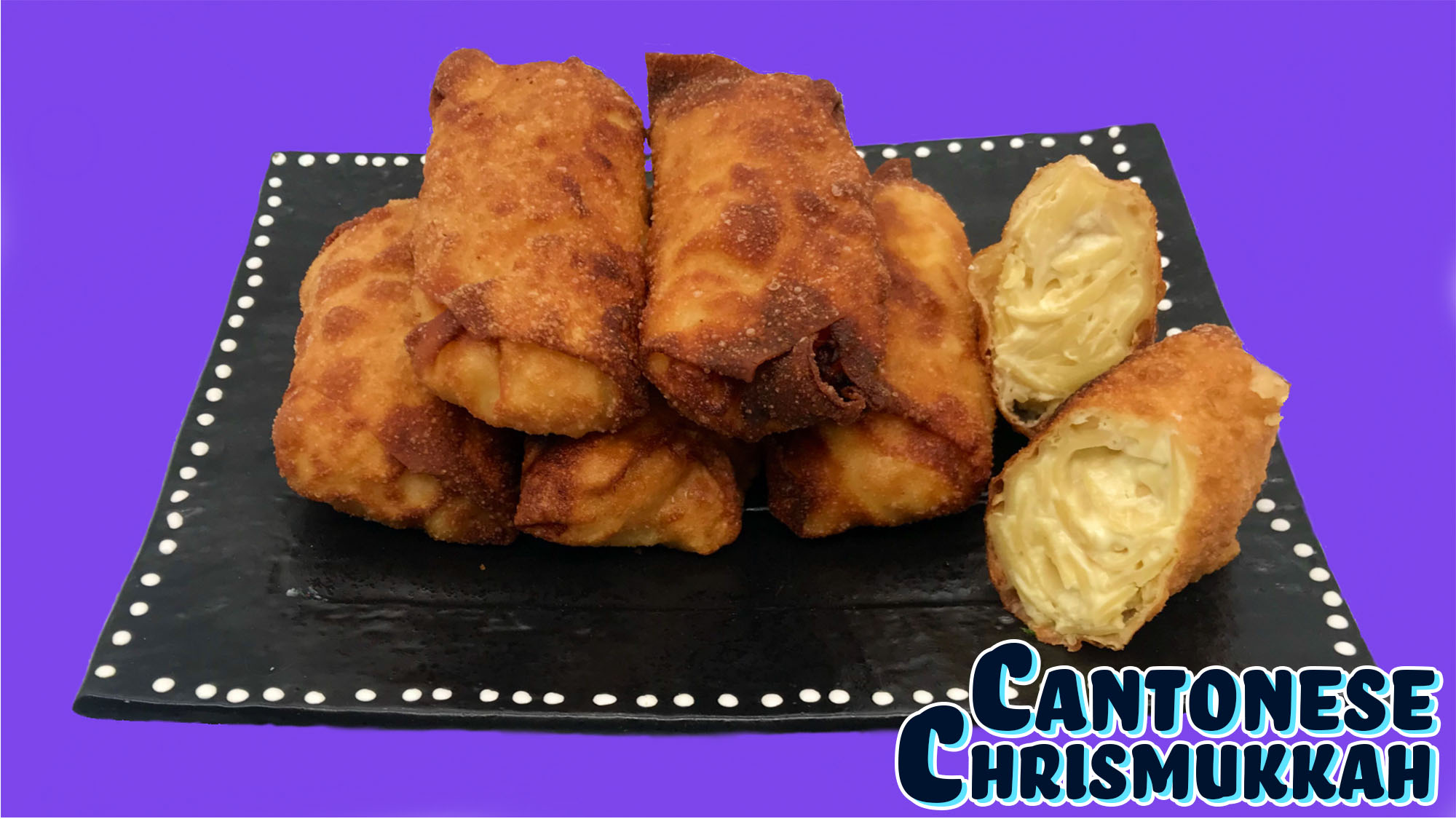The Miracle Of The Noodle Kugel Egg Rolls
Christmas Day is a holiday on which many Jewish Americans enjoy a tradition of going to the movies and eating Chinese food. But this year, Christmas falls right in the middle of the eight days of Hanukkah, so we're presenting recipes that meld traditional Jewish dishes with American Chinese classics. We hope you enjoy this Cantonese Chrismukkah menu. It's not strictly kosher, but it does celebrate a particular Jewish-American family tradition. (You'll have to choose your own movie.)
There are few foods more likable in the Jewish tradition than noodle kugel, a pudding made with sweet cheese and egg noodles; they appear on holiday tables all year long. And there are few foods more likable in the Chinese tradition than egg rolls, those wonderful deep-fried bundles of meat, cabbage, and other vegetables; why else would they be included as a free add-on in every lunch special?
Now we combine those two great traditions into Noodle Kugel Egg Rolls. This also honors the Jewish imperative to eat as much fried food as possible during the eight days of Hanukkah.
Why do we eat so much fried food? So glad you asked! (Or, if you are like my Catholic nephew and just want to get to the food, please feel free to skip the next two paragraphs.) We do it to celebrate a miracle. After a band of guerrilla warriors called the Maccabees fought back the Syrian Greeks who had conquered ancient Israel in the second century BCE, they immediately went to repair and rededicate the central temple in Jerusalem, which had been repurposed by the Greeks to honor their own gods. When they went to relight the eternal flame, the symbol of God's enduring presence, they realized that they had just enough oil for a single day and it would take at least a week to get more. But, lo, the oil burned for eight days! Which is why Hanukkah lasts for as long as it does, and why we light candles every night and why we try to consume as much oil as possible.
At least that's the version of the Hanukkah story I learned as a small child (and also play-acted in nursery school; and no, it never occurred to me how weird it was that we were pretending to be oppressed). The truth is a bit more complicated. There's also the fact that Hanukkah is considered a relatively minor festival and has only become widely celebrated even by secular Jews in the past 100 years or so when Americans needed some way to console their children who wondered why Santa was ignoring them.
Anyway, for this lovely Noodle Kugel Egg Roll, Allison takes the sweetness of the kugel and wraps it up in an egg roll wrapper and deep-fries it for extra crunch. This, too, is a holiday miracle. And yes, depending on the ingredients you use, it can be kosher.

Noodle Kugel Egg Rolls
Makes 12 egg rolls
- 1 (12-oz.) bag extra-wide egg noodles
- 8 oz. cream cheese
- 2/3 cup sugar
- 1 cup cottage cheese
- 1/2 cup sour cream
- 1 1/2 tsp. vanilla
- 1/4 tsp. salt
- 1 egg
- 2 egg yolks (reserve whites for egg wash)
- 12 egg roll wrappers
- Oil, for frying
Optional
- 1/2 cup frozen blueberries
- 1/2 cup chocolate chips
Use a wooden spoon to roughly smoosh up the cream cheese and sugar in a large bowl. It doesn't need to be smooth—you just want to break the cream cheese up into smaller pieces.
Bring a generously salted pot of water to a boil. Cook egg noodles according to package directions and drain. Dump the hot noodles on top of the cream cheese mixture and stir until the cream cheese is melted, then stir in the cottage cheese, sour cream, vanilla, salt, eggs, and yolks. Pour into a rectangular baking pan, cover with plastic wrap, and refrigerate for at least one hour until cold.
Pour at least 4 inches of frying oil into a Dutch oven and clip on a thermometer. Put over high heat until the oil reaches around 375 degrees Fahrenheit.
In the pan, cut the noodle kugel once down the middle lengthwise, then rotate the pan and make five more short cuts so that you've divided the kugel into 12 pieces. Whisk the reserved egg whites well with 1 Tbsp. water to make an egg wash.
To assemble
Lay out an egg roll wrapper so that it's in the shape of a diamond and brush with egg wash. Scoop out one piece of kugel and place in the center of the wrapper. (If you would like, smoosh a few frozen blueberries or chocolate chips into the kugel—you don't need to be pretty about it). Fold the bottom point over the filling, brush with a bit more egg wash, then fold in the sides and roll up just like you would a burrito.
Deep-fry the egg rolls, no more than four at a time, until golden—about four minutes. Let cool for five minutes before serving.
